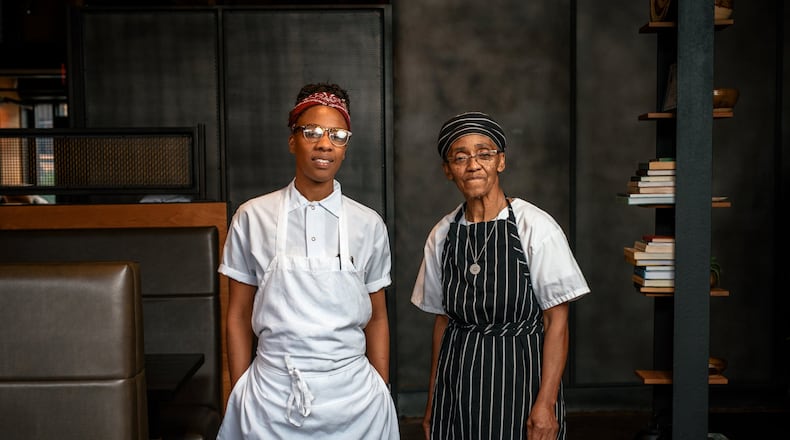Ashleigh Shanti’s great-grandmother, Inez Miller, lived in a house near the Dan River in Appalachian southern Virginia. When Shanti closes her eyes to picture the house, the first image that comes to mind is the entrance.
“Her porch was always full of produce that she had picked from her garden hanging to dry. She used embroidery threads to string them because it was strong enough to hold the weight.”
Like many other Appalachian cooks, Miller stringed beans primarily, but she took the practice even further. “She would even string greens, like collards, and also hang garlic that way.”
Sounds very picturesque, doesn’t it?
“Well,” laughs Shanti. “Not everyone loved it. We saw it as a huge eyesore. We thought my great-grandmother was crazy.”
Now, not so much. Shanti's great-grandmother's technique for drying beans has inspired one of the most popular items on her menu at Benne on Eagle — the Asheville, North Carolina, restaurant that has earned her national acclaim for her deft interpretations of Appalachian foodways. This dish, called "buttermilk britches," features the dried beans in a tangy buttermilk cream sauce without any extraneous seasoning, but with the deeply savory note that drying imparts on the beans.
The word “britches” hearkens another name for these old-timey dried beans: “leather britches.” Throughout Appalachia, cooks have long preserved summer’s bounty of snap beans not by canning them, but by hanging garlands of them to dry in the sun until they became as brown and leathery as old suspenders. Then they would pack them into jars to use throughout the winter.
Not just any beans did the job. The home cooks of yesteryear favored an heirloom variety — all but forgotten but now resurgent — called “greasy beans” for their smooth, fuzzless pods that look shiny when cooked.
They also knew that drying the beans had benefits beyond mere preservation. For one, the dried beans, cooked for hours with salt pork, retained a bit of chew instead of falling apart into mush. For another, they developed a stronger flavor. “I remember those dried beans having this meaty taste,” recalls Shanti, “even when (my great-grandmother) didn’t use seasoning meat. Now I know that as umami. It’s a depth of flavor you wouldn’t get from cooking fresh green beans in the same way.”
According to the Umami Information Center, peas and beans are among the vegetables with the highest naturally occurring glutamates — about 110 milligrams per 100 grams. Drying the beans simply concentrates the umami into something that tastes meaty and makes the mouth water, much like sun-dried tomatoes do.
Chef Sean Brock has long touted the umami of the leather britches he grew up eating in southwestern Virginia. And in her James Beard Award-winning cookbook, “Victuals: An Appalachian Journey, with Recipes,” Ronni Lundy wrote about the deeply meaty flavor of leather britches and helped repopularize the technique. “I had never made the connection to leather britches until I read ‘Victuals,’” says Shanti. “My mother just called it ‘stringing beans.’”
Shanti thought of this recipe when executive chef John Fleer charged her with developing a menu for Benne on Eagle, which would be located in the new Foundry Hotel near downtown Asheville. The area, once called “The Block,” was home to a significant African American population. Fleer was keen to find a chef who would research and honor the contributions black cooks made to the local culinary vernacular.
After some experimentation, Shanti found that dragon tongue beans make a good substitute for greasy beans, though she now has a local farmer growing greasy beans for her. While her great-grandmother would dry her beans for two weeks, she finds that four or five days does the trick.
In standard recipes, the beans simmer with a piece of salt pork for the few hours it takes for them to become tender. Shanti puts her own spin on the proceedings by rehydrating the beans in buttermilk, cooking them in a cream sauce and then folding a bit more buttermilk into the sauce. “It’s so simple but people really love it.”
Shanti says she constantly has strings of beans and now collards hanging all over the prep kitchen. At first she took advantage of the impressive mezzanine rail in the restaurant, which is built in the site of an actual former steel foundry. And then she realized she was turning into her great-grandmother.
“Man, it was an eyesore,” she says.
RELATED:
Read more stories like this by liking Atlanta Restaurant Scene on Facebook, following @ATLDiningNews on Twitter and @ajcdining on Instagram.
About the Author
The Latest
Featured


